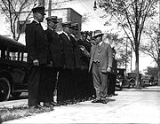
Minneapolis Police Department
Encyclopedia
The Minneapolis Police Department (MPD) is the police department for the city of Minneapolis
in the U.S. state
of Minnesota
. Formed in 1867, it is the second oldest police department in the state of Minnesota, after the Saint Paul Police Department (formed in 1854). A short-lived Board of Police Commissioners existed from 1887 to 1890. The modern department is organized into three bureaus all reporting to Chief of Police Tim Dolan.
The city is served through five precincts with 800 sworn officers and 300 civilian employees. At the city's population peak, MPD served over 521,000 people, and today serves over 382,000 people as of the last Census estimate.
Other independent protection organizations serve the city, identified as partner law enforcement agencies, these are the University of Minnesota Police Department (UMPD), Minneapolis Park Police, Metro Transit Police, and the Hennepin County Sheriff's Office. The Metropolitan Airports Commission Police serves the Minneapolis-Saint Paul International Airport
in unincorporated Hennepin County.
until the Hennepin County Courthouse and Jail was built in 1857. When the two cities merged and incorporated as Minneapolis in 1867, Mayor
Dorilus Morrison
immediately appointed H. H. Brackett as the first police chief. With six patrolmen, the new Police Department of Minneapolis served a population of about 5,000 people. In 1884, the force numbered 100 men and Shingle Creek workhouse was completed.
In 1887, by act of the new Minnesota Legislature
and accorded by the Minneapolis City Council
, the Board of Police Commissioners was appointed. Vesting all control of the force to the Board, it was an attempt to thwart the corrupt Mayor "Doc" Ames
who had replaced the police force with crooks. The Board was short-lived for three terms until it was abolished in 1890 and a new mayor was elected. Military titles were also abolished. By then the city grew to 200,000 people with 200 officers on a budget of $209,278. Patrols were done on foot and by horseback with headquarters at city hall
. By 1909, the department added motorcycles, fingerprinting, and utilized telephones.
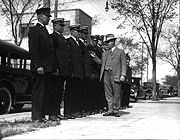 In the 1920s, criminal activity had grown to an alarming level. Saint Paul's Chief of Police, John J. O'Connor
In the 1920s, criminal activity had grown to an alarming level. Saint Paul's Chief of Police, John J. O'Connor
, established the O'Connor System which allowed gang-land criminals to live in the city as long as they committed no crimes there. In exchange, police provided protection and tips regarding impending federal raids and helped keep criminals free by refusing to extradite them elsewhere. As a result, high-profile criminals such as Machine Gun Kelly
, John Dillinger
and Baby Face Nelson
took refuge in St. Paul and committed crimes across the region, including Minneapolis. These criminals then fled to St. Paul, where they were all but untouchable. Soon, the corruption spread to the Minneapolis Police Department, who instituted their own similar system. An Irishman named Edward G. "Big Ed" Morgan operated a gambling den under police protection but also commanded crime in partnership with Prohibition bootleggers. Then, Danny Hogan
, an underworld "Godfather" of Saint Paul allied with Morgan.
Minneapolis also raided and investigated its own Chinese population of the Chinese Exclusion Act era. In 1925, Chief Frank Brunskill instructed captains to "investigate every Chinese on his beat" for naturalization papers or other identification. These round-ups were a response to Minneapolis events of the Tong wars killings between the local Hip Sing Tong and On Leong Tong
. The raids and arrests were ineffective and no Chinese were deported. The tensions faded with the gradual assimilation of the city's small Chinese population and repeal of exclusion laws.
The Great Depression
and the 1930s followed similarly to other growing U.S. cities as the department quelled labor disputes and continued to fight gangsters during the waning years of Prohibition
. On December 16, 1932, members of the infamous Barker-Karpis
gang robbed the Third Northwestern Bank in downtown Northeast, Minneapolis
and killed responding policemen Ira Leon Evans and Leo Gorski. The sensational manner in which the gang blasted their way out led to an intense manhunt that netted some of the culprits but not the leaders who had fled. In a sign of the Great Depression
, the city controller's office revealed that the two patrolmen had been working without pay due to a shortage in the police fund. Mayor Anderson blamed "large taxpayers" as not paying their fair share of taxes, shortening the police budget and limiting the department's ability to fund and equip officers.
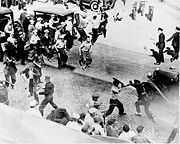 The Minneapolis Teamsters Strike of 1934
The Minneapolis Teamsters Strike of 1934
was set in May 1934 in the city market (North Loop, Minneapolis
) when a new truckers union was not recognized. MPD attempted to open the markets which were the source of most goods and produce in the city but were blocked by teamsters. Assisted by the Minnesota National Guard
and a local militia, the two sides clashed violently for a month with police using gas bombs and brandishing rifles. It ended on August 21 when the union was recognized. Though 200 were injured and four were killed, the strike was a significant event in state and national labor history.
During World War II
, 117 MPD officers were sent to Europe. At home, the stress of the war and fear of attack developed into air raid drills where two wardens were assigned to each city block. Following the war, the program was chartered by the city as the Police Reserve under MPD's Civil Defense unit in 1952. The Reserve bolsters MPD presence at major events to this day.
With American prosperity, Minneapolis reached its peak population of over 571,000 in the 1950 Census and MPD had nearly 600 sworn officers. The demographics of Minneapolis
also identified in the 1950 census as 98% white. While national politics
and anti-communism
sentiment played out during this decade, urban renewal
ravaged the downtown areas and cleared slums, impacting poor communities. Police contended with protests to this clearance and freeway and expressway revolts
later in the 1960s.
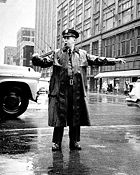 The 1960s posed new challenges to the department from increased drug use, counterculture
The 1960s posed new challenges to the department from increased drug use, counterculture
, and societal unrest. Rioting in Minneapolis followed similarly to inequality riots across many major U.S. cities during that era in predominantly African-American communities. Most notably, the Plymouth Avenue Riots in the Near North
neighborhood, instigated by East Coast protesters, effectively emptied the area of Jewish and German businesses. The Police Department's poor engagement with the riots resulted in the Community Relations Division and the Model Cities Precinct in 1970. The Minneapolis Domestic Violence Experiment
was conducted in 1981 and the study's prolific release led to changes in police protocol with domestic calls in other departments, notably, New York City, Dallas, and New Zealand. From this tumultuous era, the construction of the freeway system and subsequent white flight
emptied Minneapolis' population to a low of 350,000 in 1990. However the demand for policing continued to rise to over 700 officers in that decade as drug use and gang activity continued to accelerate.
beating trial in Los Angeles
led to one of Minneapolis' darkest moments. On September 25, 1992, Officer Jerome (Jerry) Haaf was taking a break at the officers' popular Pizza Shack restaurant in Phillips
and was shot behind the back by two Vice Lord gang members. The investigator with him was also wounded. Haaf died from his wounds at Hennepin County Medical Center
and the members were later caught, convicted and sent to prison. Chief John Laux suggested the murder was possibly retaliation for an earlier incident in which Metro Transit Police removed a blind black man who did not have bus fare. At a community meeting earlier in the evening at North Community High School
, gang members interrupted calling police brutality and insensitivity. A Vice Lord leader under the guise of a non-profit group called United For Peace which called for Minneapolis to be a sanctuary for gangs, was suspected of orchestrating the murder. Though not convicted of Officer Haaf's death, the leader was sent to prison in excess of 20 years for a separate incident. The group's message had exacerbated a real ongoing issue of police brutality in the latter century. Former police chief Tony Bouza who oversaw the department in the 1980s called the force at the time "brutal." Mayor Sharon Sayles Belton, an African-American herself, stated in 1994 that excessive force was a problem.
In 1995, Mark Koscielski, a gun shop owner in present day Midtown Phillips coined the term "murderapolis." His T-shirts featuring the derisive term were quoted in a New York Times article. Murders had indeed peaked that year and the department sent three officers to New York City
to study the Fixing Broken Windows
crime-prevention program implemented by then Mayor
Rudy Giuliani
and Police Chief William Bratton. The officers returned to implement a new policing strategy, the Computer Optimized DEployment - Focus On Results (CODEFOR). A computer-based system, the strategy involves every unit of the MPD from patrol to special units to identify and concentrate policing on hot spots of crime. As technology has improved, the department continued to collect and increase reliance on statistical and data-based information.
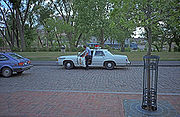 MPD's community relations further diminished with minority communities, notably Somalis
MPD's community relations further diminished with minority communities, notably Somalis
into the 2000s. In 2001, the tactic of racial profiling came to issue as the State Legislature attempted to mandate data collection of a person's race in traffic stops to reveal profiling trends. Though the measure was defeated, departments were offered incentives to volunteer for a pilot project to collect the data. MPD released its report in 2003 indicating it was more likely to stop a non-white person. The city under Mayor R.T. Rybak convened an audit of MPD to determine why and formulate steps to address the issue.
Communication between MPD and the community was strengthened when Community Crime Prevention/Safety for Everyone (CCP/SAFE) specialists were created to assist neighborhoods in organizing block clubs
and disseminate crime information to residents. The Neighborhood Revitalization Program (NRP) which began in 1960 has just begun to realize its infrastructure and community improvements, as neighborhoods once severely impacted by crime and deterioration had begun to turn around. The Whittier neighborhood
became a model example of the program's benefit. CODEFOR finally reached a decade of data collection revealing definitive crime trends and in 2007, the precincts implemented official neighborhood policing plans based on this data.
In 1998, the re-routing of Minnesota State Highway 55
brought protests from the Hiawatha neighborhood
of Longfellow community
and members of the Mendota Mdewakanton community. Police protection was ordered for construction workers. In July 2000, a clash with protesters at an International Society of Animal Genetics conference and a following raid on a non-profit office suspected of organizing the protest drew attention of the City Council. They publicly questioned Chief Olson who revealed that 40 undercover police agents were in the demonstrations and that 400 to 500 Minneapolis police officers were assigned to the week-long conference.
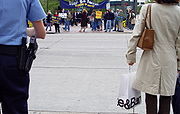 In 2002, Olson was accused of stalling federal U.S. Department of Justice mediation between the MPD and hometown civil rights groups focused around North Minneapolis. Unpopular with Mayor R. T. Rybak
In 2002, Olson was accused of stalling federal U.S. Department of Justice mediation between the MPD and hometown civil rights groups focused around North Minneapolis. Unpopular with Mayor R. T. Rybak
, Olson was ousted in 2003 and William McManus was appointed, former chief of Dayton, Ohio
, and former assistant chief in Washington, D.C.
His tenure was intended to reverse Olson's past actions. McManus worked on improving internal promotions and politics within the department to achieve racial equality in officer ranks. The attempted overhaul of Internal Affairs and greater attention over policing did generate larger respect for the department from communities of color and even gang members. However, his support was split in the Council, and though personally endorsed, he conflicted with Mayor Rybak over promotions and the handling of the 2003 Duy Ngo incident, in which Ngo, an undercover officer, was shot by another officer. In early 2006, facing an uncertain reconfirmation for a second three-year term, McManus sought and accepted the police chief position in San Antonio, Texas
.
Though McManus improved internal diversity during his tenure, his efforts did not address department racism, traced to former chief Olson. In December 2007, five high ranking black police officers filed a lawsuit against the department alleging a long history of systemic racial discrimination and a hostile working environment toward black officers and in April 2009, the city settled with them for $740,000.
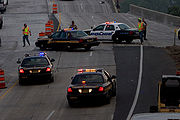 Assistant Chief Tim Dolan succeeded McManus and was shortly promoted to Police Chief. Sharon Lubinski
Assistant Chief Tim Dolan succeeded McManus and was shortly promoted to Police Chief. Sharon Lubinski
was appointed Assistant Chief. Under Chief Dolan's watch, the I-35W Mississippi River bridge collapsed on August 1, 2007. Agencies involved in the recovery efforts operated smoothly under post 9/11 disaster and emergency management training. Providing 75 law enforcement units, the MPD's immediate role was to ensure safety and control of neighborhoods surrounding the bridge. For several months after, the traffic control unit was on call to direct traffic. The Minneapolis Emergency Communications Center (911 center) was recognized in 2008 for their efficient role in the incident.
and the Assistant Chief. The department is organized into three administrative bureaus: Patrol, Investigations, and Professional Standards each led by a Deputy Chief. The Patrol Bureau divides the city into five precincts each with a Precinct Commander, given the rank of Inspector. MPD operates under a decentralized structure giving independence to each precinct and bureau to manage crime and policing.
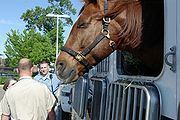
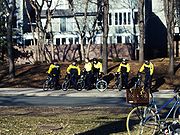 The Minneapolis Mounted Patrol Unit is headquartered at the First Precinct and has 8 full-time riders of the 30 fully trained MPD sworn officers in the unit. It is the largest mounted patrol
The Minneapolis Mounted Patrol Unit is headquartered at the First Precinct and has 8 full-time riders of the 30 fully trained MPD sworn officers in the unit. It is the largest mounted patrol
in the five-state Upper Midwest
and operates on donations. Minneapolis owns 11 horses that commute from a rented barn in Delano, Minnesota
. Part of the older waterworks plant in Columbia Heights will be converted into a new stable.
The Minneapolis Police Canine Unit has 17 canine teams and the training facility is in Northeast, Minneapolis
.
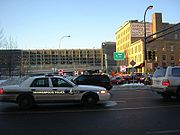
as the civil defense force in anticipation of a nuclear attack during the Cold War
, the reserve's role diminished after the Soviet-era. The unit's responsibility however was reaffirmed after the attacks of September 11, 2001 and was reassigned under the Minneapolis Police Department's Emergency Preparedness Coordinator, tasked with domestic defense in situations of civil unrest and disasters. Though officers are not on regular active patrols, they are on-call 24 hours and respond to rioting, protests, officer shootings, large crime scenes, fires and explosions, and natural disasters, as well as events requiring a security presence such as dignitaries and concerts. They also provide officers to traffic control.
The MPD also has other volunteer activities including
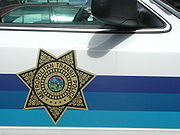 Five other police forces operate in Minneapolis with the Minneapolis Police Department being the largest.
Five other police forces operate in Minneapolis with the Minneapolis Police Department being the largest.
Minneapolis, Minnesota
Minneapolis , nicknamed "City of Lakes" and the "Mill City," is the county seat of Hennepin County, the largest city in the U.S. state of Minnesota, and the 48th largest in the United States...
in the U.S. state
U.S. state
A U.S. state is any one of the 50 federated states of the United States of America that share sovereignty with the federal government. Because of this shared sovereignty, an American is a citizen both of the federal entity and of his or her state of domicile. Four states use the official title of...
of Minnesota
Minnesota
Minnesota is a U.S. state located in the Midwestern United States. The twelfth largest state of the U.S., it is the twenty-first most populous, with 5.3 million residents. Minnesota was carved out of the eastern half of the Minnesota Territory and admitted to the Union as the thirty-second state...
. Formed in 1867, it is the second oldest police department in the state of Minnesota, after the Saint Paul Police Department (formed in 1854). A short-lived Board of Police Commissioners existed from 1887 to 1890. The modern department is organized into three bureaus all reporting to Chief of Police Tim Dolan.
The city is served through five precincts with 800 sworn officers and 300 civilian employees. At the city's population peak, MPD served over 521,000 people, and today serves over 382,000 people as of the last Census estimate.
Other independent protection organizations serve the city, identified as partner law enforcement agencies, these are the University of Minnesota Police Department (UMPD), Minneapolis Park Police, Metro Transit Police, and the Hennepin County Sheriff's Office. The Metropolitan Airports Commission Police serves the Minneapolis-Saint Paul International Airport
Minneapolis-Saint Paul International Airport
Minneapolis-Saint Paul International Airport is the largest and busiest airport in the five-state upper Midwest region of Minnesota, Iowa, South Dakota, North Dakota, and Wisconsin.-Overview:...
in unincorporated Hennepin County.
History
In the 1800s, the City of St. Anthony and Town of Minneapolis were first adequately served by an appointed city marshal based out of St. Anthony who was assisted by constables. Vested with the power of arrest, they rarely used it. Criminals sentenced would be sent to Ramsey County Jail or the Stillwater PenitentiaryMinnesota Territorial Prison
The Minnesota Territorial Prison, later known as the Minnesota State Prison, was a prison in Stillwater, Minnesota, operated from 1853 - 1914. Construction of the prison began in 1851, shortly after Minnesota became a territory...
until the Hennepin County Courthouse and Jail was built in 1857. When the two cities merged and incorporated as Minneapolis in 1867, Mayor
Mayor
In many countries, a Mayor is the highest ranking officer in the municipal government of a town or a large urban city....
Dorilus Morrison
Dorilus Morrison
Dorilus Morrison was a banker, businessman, and politician who lived in the U.S. state of Minnesota. He was the first and third mayor of Minneapolis. Morrison was born in Livermore, Maine, and was a lumber merchant in Bangor, Maine before moving to Minnesota. He was the cousin of William D...
immediately appointed H. H. Brackett as the first police chief. With six patrolmen, the new Police Department of Minneapolis served a population of about 5,000 people. In 1884, the force numbered 100 men and Shingle Creek workhouse was completed.
In 1887, by act of the new Minnesota Legislature
Minnesota Legislature
The Minnesota Legislature is the legislative branch of government in the U.S. state of Minnesota. It is a bicameral legislature located at the Minnesota Capitol in Saint Paul and it consists of two houses: the lower Minnesota House of Representatives and the Minnesota Senate...
and accorded by the Minneapolis City Council
Minneapolis City Council
The Minneapolis City Council is the governing body of the City of Minneapolis. The City Council is composed of 13 single member districts, called wards. Barbara Johnson is president of the council. The council is dominated by members of the DFL Party with 12 members. The Green Party has one member...
, the Board of Police Commissioners was appointed. Vesting all control of the force to the Board, it was an attempt to thwart the corrupt Mayor "Doc" Ames
A. A. Ames
Albert Alonzo "Doc" Ames held three consecutive terms as mayor of Minneapolis, Minnesota. Dr. Ames was known for his service to his country and assistance of the poor, sometimes giving medical treatment to those who could not afford it. However, he became exceedingly more famous by creating the...
who had replaced the police force with crooks. The Board was short-lived for three terms until it was abolished in 1890 and a new mayor was elected. Military titles were also abolished. By then the city grew to 200,000 people with 200 officers on a budget of $209,278. Patrols were done on foot and by horseback with headquarters at city hall
Minneapolis City Hall
Minneapolis City Hall and Hennepin County Courthouse , designed by Long and Kees in 1888, is the main building used by the city government of Minneapolis, Minnesota as well as by Hennepin County, Minnesota...
. By 1909, the department added motorcycles, fingerprinting, and utilized telephones.
Mobs and fear

History of the Irish in Saint Paul
Irish in Saint Paul, Minnesota have played an integral part in the founding and the growth of the city. The first Irish to settle in Saint Paul were three soldiers from Fort Snelling who were natives of Ireland. They became the first settlers in the area of downtown Saint Paul...
, established the O'Connor System which allowed gang-land criminals to live in the city as long as they committed no crimes there. In exchange, police provided protection and tips regarding impending federal raids and helped keep criminals free by refusing to extradite them elsewhere. As a result, high-profile criminals such as Machine Gun Kelly
Machine Gun Kelly
George Kelley Barnes , better known as "Machine Gun Kelly", was an American gangster during the prohibition era. His nickname came from his favorite weapon, a Thompson submachine gun. His most famous crime was the kidnapping of oil tycoon & businessman Charles Urschel in July 1933 for which he,...
, John Dillinger
John Dillinger
John Herbert Dillinger, Jr. was an American bank robber in Depression-era United States. He was charged with, but never convicted of, the murder of an East Chicago, Indiana police officer during a shoot-out. This was his only alleged homicide. His gang robbed two dozen banks and four police stations...
and Baby Face Nelson
Baby Face Nelson
Lester Joseph Gillis , known under the pseudonym George Nelson, was a bank robber and murderer in the 1930s. Gillis was known as Baby Face Nelson, a name given to him due to his youthful appearance and small stature...
took refuge in St. Paul and committed crimes across the region, including Minneapolis. These criminals then fled to St. Paul, where they were all but untouchable. Soon, the corruption spread to the Minneapolis Police Department, who instituted their own similar system. An Irishman named Edward G. "Big Ed" Morgan operated a gambling den under police protection but also commanded crime in partnership with Prohibition bootleggers. Then, Danny Hogan
Danny Hogan
"Dapper" Danny Hogan was a charismatic underworld figure and boss of Saint Paul, Minnesota's Irish Mob during Prohibition. Due to his close relationships with the officers of the deeply corrupt St...
, an underworld "Godfather" of Saint Paul allied with Morgan.
The police of Minneapolis and St. Paul are said not to interfere with these criminals, there being an understanding between Dan Hogan and the St. Paul Police and Edward Morgan and the Minneapolis Police that if the criminal gangs controlled by them refrain from committing crime in the Twin Cities, that they will not be disturbed. It is a well known fact in the community that a very little crime such as bank robberies, etc, is committed here, the criminals are safe as long as they live up to the pledge made by Dan Hogan and Edward Morgan to the local police.|1926 FBI Memo|
Minneapolis also raided and investigated its own Chinese population of the Chinese Exclusion Act era. In 1925, Chief Frank Brunskill instructed captains to "investigate every Chinese on his beat" for naturalization papers or other identification. These round-ups were a response to Minneapolis events of the Tong wars killings between the local Hip Sing Tong and On Leong Tong
On Leong Tong
The On Leong Chinese Merchants Association or simply Chinese Merchants Association, formerly known as the On Leong Tong , was a tong society operating out of its territory in Mott Street in New York's Chinatown. Established in November, 1893, the tong fought a violent war for control of...
. The raids and arrests were ineffective and no Chinese were deported. The tensions faded with the gradual assimilation of the city's small Chinese population and repeal of exclusion laws.
The Great Depression
Great Depression
The Great Depression was a severe worldwide economic depression in the decade preceding World War II. The timing of the Great Depression varied across nations, but in most countries it started in about 1929 and lasted until the late 1930s or early 1940s...
and the 1930s followed similarly to other growing U.S. cities as the department quelled labor disputes and continued to fight gangsters during the waning years of Prohibition
Prohibition
Prohibition of alcohol, often referred to simply as prohibition, is the practice of prohibiting the manufacture, transportation, import, export, sale, and consumption of alcohol and alcoholic beverages. The term can also apply to the periods in the histories of the countries during which the...
. On December 16, 1932, members of the infamous Barker-Karpis
Ma Barker
Kate "Ma" Barker was the mother of several criminals who ran the Barker gang from the "public enemy era", when the exploits of gangs of criminals in the U.S. Midwest gripped the American people and press...
gang robbed the Third Northwestern Bank in downtown Northeast, Minneapolis
Northeast, Minneapolis
Northeast is a defined community in the U.S. city of Minneapolis, Minnesota, composed of 13 smaller neighborhoods whose street addresses end in "NE". Unofficially it also includes the neighborhoods of the University community which have "NE" addresses, and the entirety of the Old Saint Anthony...
and killed responding policemen Ira Leon Evans and Leo Gorski. The sensational manner in which the gang blasted their way out led to an intense manhunt that netted some of the culprits but not the leaders who had fled. In a sign of the Great Depression
Great Depression
The Great Depression was a severe worldwide economic depression in the decade preceding World War II. The timing of the Great Depression varied across nations, but in most countries it started in about 1929 and lasted until the late 1930s or early 1940s...
, the city controller's office revealed that the two patrolmen had been working without pay due to a shortage in the police fund. Mayor Anderson blamed "large taxpayers" as not paying their fair share of taxes, shortening the police budget and limiting the department's ability to fund and equip officers.
Labor strikes and domestic changes

Minneapolis Teamsters Strike of 1934
The Minneapolis General Strike of 1934 grew out of a strike by Teamsters against most of the trucking companies operating in Minneapolis, a major distribution center for the Upper Midwest. The strike began on May 16, 1934 in the Market District and ensuing violence lasted periodically throughout...
was set in May 1934 in the city market (North Loop, Minneapolis
North Loop, Minneapolis
The North Loop is a neighborhood of the Central community of Minneapolis, Minnesota. The neighborhood is commonly known as the Warehouse District from the city's shipping hub years. It includes the Minneapolis Warehouse Historic District which is listed on the National Register of Historic Places...
) when a new truckers union was not recognized. MPD attempted to open the markets which were the source of most goods and produce in the city but were blocked by teamsters. Assisted by the Minnesota National Guard
Minnesota National Guard
The Minnesota National Guard is composed of approximately 14,000 soldiers of the Minnesota Army National Guard and Airmen of the Minnesota Air National Guard, serving in 63 communities across the state. The Constitution of the United States specifically charges the National Guard with dual federal...
and a local militia, the two sides clashed violently for a month with police using gas bombs and brandishing rifles. It ended on August 21 when the union was recognized. Though 200 were injured and four were killed, the strike was a significant event in state and national labor history.
During World War II
World War II
World War II, or the Second World War , was a global conflict lasting from 1939 to 1945, involving most of the world's nations—including all of the great powers—eventually forming two opposing military alliances: the Allies and the Axis...
, 117 MPD officers were sent to Europe. At home, the stress of the war and fear of attack developed into air raid drills where two wardens were assigned to each city block. Following the war, the program was chartered by the city as the Police Reserve under MPD's Civil Defense unit in 1952. The Reserve bolsters MPD presence at major events to this day.
With American prosperity, Minneapolis reached its peak population of over 571,000 in the 1950 Census and MPD had nearly 600 sworn officers. The demographics of Minneapolis
Demographics of Minneapolis, Minnesota
Minneapolis is the largest city in the U.S. state of Minnesota and the county seat of Hennepin County. As of the 2010 Census, the population of Minneapolis was 385,378-Population and age:...
also identified in the 1950 census as 98% white. While national politics
1950s
The 1950s or The Fifties was the decade that began on January 1, 1950 and ended on December 31, 1959. The decade was the sixth decade of the 20th century...
and anti-communism
Anti-communism
Anti-communism is opposition to communism. Organized anti-communism developed in reaction to the rise of communism, especially after the 1917 October Revolution in Russia and the beginning of the Cold War in 1947.-Objections to communist theory:...
sentiment played out during this decade, urban renewal
Urban renewal
Urban renewal is a program of land redevelopment in areas of moderate to high density urban land use. Renewal has had both successes and failures. Its modern incarnation began in the late 19th century in developed nations and experienced an intense phase in the late 1940s – under the rubric of...
ravaged the downtown areas and cleared slums, impacting poor communities. Police contended with protests to this clearance and freeway and expressway revolts
Freeway and expressway revolts
Many freeway revolts took place in developed countries during the 1960s and 1970s, in response to plans for the construction of new freeways, a significant number of which were abandoned or significantly scaled back due to widespread public opposition; especially of those whose neighborhoods would...
later in the 1960s.
Counterculture and riots

Counterculture
Counterculture is a sociological term used to describe the values and norms of behavior of a cultural group, or subculture, that run counter to those of the social mainstream of the day, the cultural equivalent of political opposition. Counterculture can also be described as a group whose behavior...
, and societal unrest. Rioting in Minneapolis followed similarly to inequality riots across many major U.S. cities during that era in predominantly African-American communities. Most notably, the Plymouth Avenue Riots in the Near North
Near North, Minneapolis
Near North is a community on the north side of Minneapolis. Contained within it are six smaller neighborhoods. Near North is the primary area represented in the North Minneapolis Encyclopedia, InsideNorthside....
neighborhood, instigated by East Coast protesters, effectively emptied the area of Jewish and German businesses. The Police Department's poor engagement with the riots resulted in the Community Relations Division and the Model Cities Precinct in 1970. The Minneapolis Domestic Violence Experiment
Minneapolis Domestic Violence Experiment
The Minneapolis Domestic Violence Experiment was a study done in 1981-1982, led by Lawrence W. Sherman, to evaluate the effectiveness of various police responses to domestic violence calls in Minneapolis, Minnesota. The study was performed with cooperation from the Police Foundation and the...
was conducted in 1981 and the study's prolific release led to changes in police protocol with domestic calls in other departments, notably, New York City, Dallas, and New Zealand. From this tumultuous era, the construction of the freeway system and subsequent white flight
White flight
White flight has been a term that originated in the United States, starting in the mid-20th century, and applied to the large-scale migration of whites of various European ancestries from racially mixed urban regions to more racially homogeneous suburban or exurban regions. It was first seen as...
emptied Minneapolis' population to a low of 350,000 in 1990. However the demand for policing continued to rise to over 700 officers in that decade as drug use and gang activity continued to accelerate.
Gangs and homicides
Tensions among gangs following the acquittal of officers in the Rodney KingRodney King
Rodney Glen King is an American best known for his involvement in a police brutality case involving the Los Angeles Police Department on March 3, 1991...
beating trial in Los Angeles
Los Ángeles
Los Ángeles is the capital of the province of Biobío, in the commune of the same name, in Region VIII , in the center-south of Chile. It is located between the Laja and Biobío rivers. The population is 123,445 inhabitants...
led to one of Minneapolis' darkest moments. On September 25, 1992, Officer Jerome (Jerry) Haaf was taking a break at the officers' popular Pizza Shack restaurant in Phillips
Phillips, Minneapolis
Phillips is a community in Minneapolis, just south of downtown. It is one of the most diverse and culturally-rich communities in Minnesota. Traditionally, it was both a community and a neighborhood . In other words, the Phillips community only contained one neighborhood, also called Phillips...
and was shot behind the back by two Vice Lord gang members. The investigator with him was also wounded. Haaf died from his wounds at Hennepin County Medical Center
Hennepin County Medical Center
Hennepin County Medical Center is a Level I trauma center based in Minneapolis, Minnesota, the county seat of Hennepin County. The primary 422-bed facility is located on five city blocks across the street from the Hubert H. Humphrey Metrodome, with satellite clinics in Minneapolis, Brooklyn...
and the members were later caught, convicted and sent to prison. Chief John Laux suggested the murder was possibly retaliation for an earlier incident in which Metro Transit Police removed a blind black man who did not have bus fare. At a community meeting earlier in the evening at North Community High School
North Community High School
North Community High School, or simply Minneapolis North, is a public, four-year high school located in Minneapolis, Minnesota. The school has existed for over 120 years in several buildings all located on the North Side of Minneapolis...
, gang members interrupted calling police brutality and insensitivity. A Vice Lord leader under the guise of a non-profit group called United For Peace which called for Minneapolis to be a sanctuary for gangs, was suspected of orchestrating the murder. Though not convicted of Officer Haaf's death, the leader was sent to prison in excess of 20 years for a separate incident. The group's message had exacerbated a real ongoing issue of police brutality in the latter century. Former police chief Tony Bouza who oversaw the department in the 1980s called the force at the time "brutal." Mayor Sharon Sayles Belton, an African-American herself, stated in 1994 that excessive force was a problem.
In 1995, Mark Koscielski, a gun shop owner in present day Midtown Phillips coined the term "murderapolis." His T-shirts featuring the derisive term were quoted in a New York Times article. Murders had indeed peaked that year and the department sent three officers to New York City
New York City
New York is the most populous city in the United States and the center of the New York Metropolitan Area, one of the most populous metropolitan areas in the world. New York exerts a significant impact upon global commerce, finance, media, art, fashion, research, technology, education, and...
to study the Fixing Broken Windows
Fixing Broken Windows
The broken windows theory is a criminological theory of the norm setting and signaling effect of urban disorder and vandalism on additional crime and anti-social behavior...
crime-prevention program implemented by then Mayor
Mayor
In many countries, a Mayor is the highest ranking officer in the municipal government of a town or a large urban city....
Rudy Giuliani
Rudy Giuliani
Rudolph William Louis "Rudy" Giuliani KBE is an American lawyer, businessman, and politician from New York. He served as Mayor of New York City from 1994 to 2001....
and Police Chief William Bratton. The officers returned to implement a new policing strategy, the Computer Optimized DEployment - Focus On Results (CODEFOR). A computer-based system, the strategy involves every unit of the MPD from patrol to special units to identify and concentrate policing on hot spots of crime. As technology has improved, the department continued to collect and increase reliance on statistical and data-based information.
Community relations

Somali American
Somali Americans are American citizens and residents born in, or with ancestors from Somalia.The first Somalis to arrive in the United States were sailors who came in the 1920s and settled in New York. In the late 1970s, more Somali immigrants followed suit...
into the 2000s. In 2001, the tactic of racial profiling came to issue as the State Legislature attempted to mandate data collection of a person's race in traffic stops to reveal profiling trends. Though the measure was defeated, departments were offered incentives to volunteer for a pilot project to collect the data. MPD released its report in 2003 indicating it was more likely to stop a non-white person. The city under Mayor R.T. Rybak convened an audit of MPD to determine why and formulate steps to address the issue.
Communication between MPD and the community was strengthened when Community Crime Prevention/Safety for Everyone (CCP/SAFE) specialists were created to assist neighborhoods in organizing block clubs
Neighborhood watch
A neighborhood watch or neighbourhood watch , also called a crime watch or neighborhood crime watch, is an organized group of citizens devoted to crime and vandalism prevention within a neighborhood...
and disseminate crime information to residents. The Neighborhood Revitalization Program (NRP) which began in 1960 has just begun to realize its infrastructure and community improvements, as neighborhoods once severely impacted by crime and deterioration had begun to turn around. The Whittier neighborhood
Whittier, Minneapolis
Whittier is a neighborhood in the U.S. city of Minneapolis, Minnesota, bounded by Franklin Avenue on the north, Interstate 35W on the east, Lake Street on the south, and Lyndale Avenue on the west. It is known for many diverse restaurants, coffee shops and Asian markets, especially along Nicollet...
became a model example of the program's benefit. CODEFOR finally reached a decade of data collection revealing definitive crime trends and in 2007, the precincts implemented official neighborhood policing plans based on this data.
In 1998, the re-routing of Minnesota State Highway 55
Minnesota State Highway 55
Minnesota State Highway 55 is a highway in west-central, central, and east-central Minnesota, which runs from the North Dakota state line near Tenney and continues east and southeast to its eastern terminus at its intersection with U.S...
brought protests from the Hiawatha neighborhood
Hiawatha, Minneapolis
Hiawatha is a neighborhood within the larger Longfellow community in Minneapolis. It is bordered by Howe to the North, the Mississippi River to the East, Minnehaha Park and Minnehaha neighborhood to the South, and Ericsson and Standish to the West....
of Longfellow community
Longfellow, Minneapolis
Longfellow is a defined community in Minneapolis, Minnesota which includes five smaller neighborhoods inside of it: Cooper, Hiawatha, Howe, Longfellow, and Seward. Grouped with South Minneapolis along the city's eastern border with the Mississippi River, Longfellow takes its name from Longfellow...
and members of the Mendota Mdewakanton community. Police protection was ordered for construction workers. In July 2000, a clash with protesters at an International Society of Animal Genetics conference and a following raid on a non-profit office suspected of organizing the protest drew attention of the City Council. They publicly questioned Chief Olson who revealed that 40 undercover police agents were in the demonstrations and that 400 to 500 Minneapolis police officers were assigned to the week-long conference.
Internal affairs

R. T. Rybak
Raymond Thomas Rybak, Jr. , known as R. T. Rybak, is the 46th and current mayor of the city of Minneapolis, Minnesota. In the 2001 election Rybak defeated incumbent Sharon Sayles Belton by a margin of 65% to 35%; the widest margin in city history for a challenge to an incumbent...
, Olson was ousted in 2003 and William McManus was appointed, former chief of Dayton, Ohio
Dayton, Ohio
Dayton is the 6th largest city in the U.S. state of Ohio and the county seat of Montgomery County, the fifth most populous county in the state. The population was 141,527 at the 2010 census. The Dayton Metropolitan Statistical Area had a population of 841,502 in the 2010 census...
, and former assistant chief in Washington, D.C.
Washington, D.C.
Washington, D.C., formally the District of Columbia and commonly referred to as Washington, "the District", or simply D.C., is the capital of the United States. On July 16, 1790, the United States Congress approved the creation of a permanent national capital as permitted by the U.S. Constitution....
His tenure was intended to reverse Olson's past actions. McManus worked on improving internal promotions and politics within the department to achieve racial equality in officer ranks. The attempted overhaul of Internal Affairs and greater attention over policing did generate larger respect for the department from communities of color and even gang members. However, his support was split in the Council, and though personally endorsed, he conflicted with Mayor Rybak over promotions and the handling of the 2003 Duy Ngo incident, in which Ngo, an undercover officer, was shot by another officer. In early 2006, facing an uncertain reconfirmation for a second three-year term, McManus sought and accepted the police chief position in San Antonio, Texas
San Antonio, Texas
San Antonio is the seventh-largest city in the United States of America and the second-largest city within the state of Texas, with a population of 1.33 million. Located in the American Southwest and the south–central part of Texas, the city serves as the seat of Bexar County. In 2011,...
.
Though McManus improved internal diversity during his tenure, his efforts did not address department racism, traced to former chief Olson. In December 2007, five high ranking black police officers filed a lawsuit against the department alleging a long history of systemic racial discrimination and a hostile working environment toward black officers and in April 2009, the city settled with them for $740,000.
Disaster management

Sharon Lubinski
Sharon Lubinski is the United States Marshal for the District of Minnesota. Lubinski is the first openly gay United States Marshal.-Early life and education:...
was appointed Assistant Chief. Under Chief Dolan's watch, the I-35W Mississippi River bridge collapsed on August 1, 2007. Agencies involved in the recovery efforts operated smoothly under post 9/11 disaster and emergency management training. Providing 75 law enforcement units, the MPD's immediate role was to ensure safety and control of neighborhoods surrounding the bridge. For several months after, the traffic control unit was on call to direct traffic. The Minneapolis Emergency Communications Center (911 center) was recognized in 2008 for their efficient role in the incident.
Organization
The head of the Minneapolis Police Department is the Chief of PoliceMinneapolis Chief of Police
There have been 49 police chiefs of the Minneapolis Police Department in the history of Minneapolis, Minnesota.-List of police chiefs:-List of city marshals:There were constables appointed as city marshals of Saint Anthony before it was joined to Minneapolis....
and the Assistant Chief. The department is organized into three administrative bureaus: Patrol, Investigations, and Professional Standards each led by a Deputy Chief. The Patrol Bureau divides the city into five precincts each with a Precinct Commander, given the rank of Inspector. MPD operates under a decentralized structure giving independence to each precinct and bureau to manage crime and policing.
Patrol Bureau
The Patrol Bureau provides comprehensive police services such as 911 response, crime prevention, traffic control and emergency services. The bureau comprises the five precincts, the Special Operations Division, Community Crime Prevention/SAFE Central and the Police Athletic League.- First Precinct


Mounted police
Mounted police are police who patrol on horseback or camelback. They continue to serve in remote areas and in metropolitan areas where their day-to-day function may be picturesque or ceremonial, but they are also employed in crowd control because of their mobile mass and height advantage and...
in the five-state Upper Midwest
Upper Midwest
The Upper Midwest is a region in the northern portion of the U.S. Census Bureau's Midwestern United States. It is largely a sub-region of the midwest. Although there are no uniformly agreed-upon boundaries, the region is most commonly used to refer to the states of Minnesota, Wisconsin, and...
and operates on donations. Minneapolis owns 11 horses that commute from a rented barn in Delano, Minnesota
Delano, Minnesota
Delano is a city in Wright County, Minnesota, United States. The population was 5,464 at the 2010 census. It is part of the Twin Cities Metropolitan Statistical Area.-Geography:...
. Part of the older waterworks plant in Columbia Heights will be converted into a new stable.
- Community Crime Prevention / Safety For Everyone (CCP/SAFE)
Special Operations Division
- Bomb-Arson Unit
- Canine
The Minneapolis Police Canine Unit has 17 canine teams and the training facility is in Northeast, Minneapolis
Northeast, Minneapolis
Northeast is a defined community in the U.S. city of Minneapolis, Minnesota, composed of 13 smaller neighborhoods whose street addresses end in "NE". Unofficially it also includes the neighborhoods of the University community which have "NE" addresses, and the entirety of the Old Saint Anthony...
.
- Homeland Security
- Police Activities League (PAL)
- Special Events/Reserve
- Strategic Operations Unit
- Special Weapons and Tactics (SWAT)
- Traffic Enforcement and Accident Investigation
- Traffic Control

Investigations Bureau
The Investigations Bureau performs comprehensive investigative services, including case management, suspect criteria, victim support and preparation of evidence for court. The bureau comprises the Criminal Investigations Division, Crime Lab and Support Services.- Investigations
Professional Standards Bureau
The Professional Standards Bureau focuses on the integrity of department employees from background screening through hiring and ongoing training and maintains the technical operations of the department. The bureau comprises the Background Unit, Internal Affairs, Mediation Compliance, Recruitment, Training, Business Technology Unit and Intellectual Properties.- Business Technology
- Internal Affairs
- Training
Volunteer units and activities
The Minneapolis Police Reserve is a volunteer 60 non-sworn officer unit in charge of emergency preparedness, general public safety, and provides major support for traffic and crowd control. Officers are non-sworn and wear a light blue uniform with black slacks. Conceived after World War IIWorld War II
World War II, or the Second World War , was a global conflict lasting from 1939 to 1945, involving most of the world's nations—including all of the great powers—eventually forming two opposing military alliances: the Allies and the Axis...
as the civil defense force in anticipation of a nuclear attack during the Cold War
Cold War
The Cold War was the continuing state from roughly 1946 to 1991 of political conflict, military tension, proxy wars, and economic competition between the Communist World—primarily the Soviet Union and its satellite states and allies—and the powers of the Western world, primarily the United States...
, the reserve's role diminished after the Soviet-era. The unit's responsibility however was reaffirmed after the attacks of September 11, 2001 and was reassigned under the Minneapolis Police Department's Emergency Preparedness Coordinator, tasked with domestic defense in situations of civil unrest and disasters. Though officers are not on regular active patrols, they are on-call 24 hours and respond to rioting, protests, officer shootings, large crime scenes, fires and explosions, and natural disasters, as well as events requiring a security presence such as dignitaries and concerts. They also provide officers to traffic control.
The MPD also has other volunteer activities including
- Police Band
- Police Chaplain Corps
- Police Explorers
- Police Athletic League (PAL)
- Block Club Leaders
- Police Precinct Advisory Councils
- McGruff House Program
- Community Justice Project
In Television
In the fall of 1990, the Department was featured on the first six episodes of Season 3 of the police reality show, COPS. The department was later featured in Season 21 of the show, which aired in 2008 and 2009.Other agencies

- The University of Minnesota Police Department (UMPD) serves the University of MinnesotaUniversity of MinnesotaThe University of Minnesota, Twin Cities is a public research university located in Minneapolis and St. Paul, Minnesota, United States. It is the oldest and largest part of the University of Minnesota system and has the fourth-largest main campus student body in the United States, with 52,557...
's Twin Cities campus. The department employs over 50 sworn officers. The Chief of Police is Greg Hestness, a former Deputy Chief of the Minneapolis Police Department. Under Hesstness' watch, the UMPD increased its cooperation with the Minneapolis Police Department and now frequently responds Minneapolis' calls for service and backs up MPD Officers in need of assistance. - The Minneapolis Park Police Department had 22 sworn patrol officers and 21 park patrol agents as of 2008 who are responsible for law enforcement in city parks.
- The Metro TransitMetro Transit (Minnesota)Metro Transit is the transit division of the Metropolitan Council, a regional governmental agency in the Minneapolis-St. Paul metro area of the U.S. state of Minnesota. Metro Transit is the largest operator of bus services in the seven-county region surrounding Minneapolis and St...
Police Department (officially Metropolitan Transit Police) patrols bus routes and light rail and as of 2008 had 60 full-time and 60 part-time officers. - The Metropolitan Airports CommissionMetropolitan Airports CommissionThe Minneapolis-Saint Paul Metropolitan Airports Commission is the owner and operator of Minneapolis-Saint Paul International Airport in Minnesota as well as six other reliever airports in the Twin Cities region, which primarily provide service to private individuals and businesses, but also have...
has a police force. - The Hennepin County Sheriff's Office with 800 licensed and civilian members is headquartered in Minneapolis.

